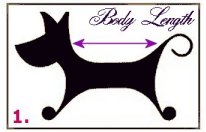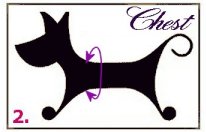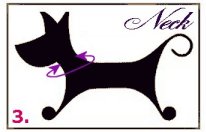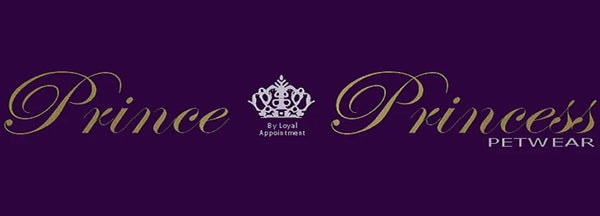The Fitting Room
|
HOW TO MEASURE FOR A DOG COLLAR HOW TO MEASURE FOR DOG CLOTHES |
HOW TO MEASURE FOR A PET HARNESS
|
Take a soft measuring tape and measure the circumference of your pet's neck, close to the shoulder where the collar will sit. When you take the measurement, the tape measure should be loose enough to fit one or two fingers comfortably underneath. Make sure that the tape can't slip over the dog’s ears. If you don't have a soft measuring tape, use a piece of string, mark your dog's neck measurement, and then measure the string against a ruler.
Choosing the Perfect Size
All Prince & Princess dog collars are sized in inches from the first to the last hole. For a perfect fit, select a collar size range that your dog's neck measurement sits in the middle of. For example if your dog's neck measurement was 14", then a 12-16" sized collar will provide a perfect fit. If your dog's neck measurement was 16" we would recommend getting the next size up, a 16-18".
Still a Perfect Fit?
After wearing a new collar for a short time, check your dog’s neck. If your dog has any redness or hair loss under the collar then adjust the collar to make it bigger. It is especially important to regularly check the fit of a puppy's collar, as they can out-grow a collar very quickly.
There are three measurements you'll need to take when sizing dog clothes:
 The Body Length
The Body Length
Measure from the base of your pet’s head (where the collar normally sits) along the backbone to the base of the tail (the point where the tail begins).
 The Chest Measurement
The Chest Measurement
Using a tape measure or string, measure the chest at the broadest point, (this is usually directly behind the front legs.)
 The Neck Circumference
The Neck Circumference
Measure the circumference of your pet’s neck as you would for a collar. Ensure that this is not tight, (you should be able to get two fingers behind the measuring tape.)
Leg Length (optional)
Measure from the point where the collar sits at the shoulder, straight down to the paws. (This measurement is not as important as the others, but it will give an indication of how far down garments will fall on the legs.)
Still the right fit?
Because every pet is different with a unique body shape, it is important that new pet clothes fit properly. Check that you can fit two fingers under the neck, that the chest is not too tight or restrictive, and that the garment is not too long.
HOW TO MEASURE FOR A CAT COLLAR
Take a soft measuring tape and measure the circumference of your cat's neck, close to the shoulder where the collar will sit. When you take the measurement, the tape measure should be loose enough to fit one or two fingers comfortably underneath. Make sure that the tape can't slip over your cat’s ears. If you don't have a soft measuring tape, use a piece of string, mark your cat's neck measurement, and then measure the string against a ruler.
Finding the Perfect Fit
Prince & Princess cat collars come in two sizes and are sized in inches from the first to the last buckle hole. For a perfect fit, select the collar that your cat's neck measurement sits in the middle of.
Still a Perfect Fit?
After wearing a new collar for a short time, check your cat’s neck. If your cat has any redness or hair loss under the collar then adjust the collar to make it bigger. It is especially important to regularly check the fit of a kitten's collar, as they can out-grow their neckwear very quickly.
HOW TO MEASURE FOR CAT CLOTHES
How to Measure for Cat Clothes
There are 3 measurements you'll need to take when sizing for cat clothes.

1. Neck - measure the circumference of the neck where the collar usually sits. You should be able to fit 2 fingers underneath the tape measure.
2. Chest - measure the widest part of the chest behind the legs.
3. Length - measure from the neck (where the collar sits) to just before the start of the tail.
Buying Based on Breed
Although, it is recommended that pets are measured before choosing new pet collars, clothes and beds etc, we know that this isn't always possible when buying gifts or for new puppies.
The size chart below is a guide only, as all pets are unique and therefore may not fit into their breed's 'standard' size. Within breeds, there will be some size variation between the genders with females being smaller (sometimes one or two sizes smaller than males of the same breed.)
Breed Guide
|
Neck |
Chest |
Body Length |
Breed (Guide Only) |
|
|
Tiny |
13 to 15cm 5.1 - 5.9" |
23 to 25cm |
15 to 17cm |
Cat, Teacup breeds, Toy and Miniature breeds, Small-breed puppies, Miniature Yorkshire, Chihauhau pup |
|
XX-Small |
17 to 19cm |
27 to 29cm |
19 to 21cm |
Cat, Chihauhau, Maltese, Miniature Poodle, Chinese Crested, Pappillion, Toy Poodle, Pomeranian, Yorkshire Terrier, Miniature Pinscher |
|
X-Small |
21 to 23cm |
31 to 33cm |
23 to 25cm |
Yorkshire Terrier, Chihauhau, Maltese Pomeranian, Cavalier King Charles, Miniature Poodle, Westie, Maltese, American Cocker (girl), Miniature Schnauzer |
|
Small |
25 to 27cm |
35 to 37cm |
27 to 29cm |
Shih Tzu, Pekingnese, Poodle Miniature Shnauzer |
|
Medium |
28 to 30cm |
43 to 45cm |
31 to 33cm |
Shih Tzu Pekingnese Mini Schnauzer, Pug |
|
Large |
31 to 33cm |
47 to 49cm |
35 to 37cm |
Fox Terrier, American Cocker Spaniel |
|
X - Large |
34 to 36cm |
51 to 53cm |
39 to 41cm |
Standard Pug, Westie, Beagle, Scottish/Cairn/Irish/Border Terrier, Shih-Tzu, Mini Poodle, English Cocker, Patterdale, Fox Terrier |
|
XX - Large |
37 to 39cm |
55 to 57cm |
43 to 45cm |
Shar Pei, Ridgeback, small Labrador (girl) Weirmaraner (girl), Afghan Hound, Airedale, Setters, Retriever |
|
Big |
40 to 42cm |
59 to 61cm |
47 to 49cm |
|
How to Measure for a Dog Harness
There are two measurements that need to be taken when sizing for a dog harness:
 The Chest Measurement
The Chest Measurement
Using a tape measure or string, measure the chest at its broadest point, (this is usually directly behind the front legs.)
 The Neck Circumference
The Neck Circumference
Measure the circumference of your pet’s neck as you would for a collar. Ensure that this is not tight, (you should be able to get two fingers behind the measuring tape) before noting the measurement.
The Princess and the Kibble
The wrong bed can leave you feeling as though you've spent the night sleeping on a piece of kibble, while the right sleeping environment can ensure you wake up revitalised and ready for the day.
There are so many decisions to be made when selecting the right pet bed that it can leave you a little confused and in need of a lie down, so it is best to get your housekeeping staff to do all of the hard work for you...
How to Choose the Right Pet Bed
Your housekeeping staff will need to assess your sleeping habits in order to decide the:
- Ideal shape and style of bed
- Filling and level of support
- Outer material
- Features needed
- Special requirements
- Extra bedding
- Correct size
1.
| Type of Sleeper | Ideal Shape / Style of Bed |
|
| Curled up | Round beds, Donut beds, nest beds (can be used on their own or as a plastic basket liner), | |
| Stretched out side/stomach/back sleeper | Flat mattress, one sided bolster beds mattress (square, rectangle and oval shaped) may be added to plastic basket or on own | |
| Head or back leaning against something | Bolster Beds (bolster all around, multiple sides or just one side), pillow, bed with edges | |
| Hiding in a quiet place | Hooded beds, cave beds, a cupboard with a bed inside | |
| On a radiator/ anywhere high up | Cat beds: radiator hammocks. |
2.
| Favourite Place to Sleep | Ideal Level of Support / Filling of Bed | ||
| Sofa | Foam mattress or pet sofa style furniture | ||
| Sofa with head supported by arm rest or human knee | Foam mattress with pillow, one sided or all sided bolster beds with good support | ||
| On the floor | Plastic or wicker dog basket with pet blanket as a liner, or just a blanket | ||
| On a human's bed | Soft poly-filled mattress, or a quilt over a pet bed | ||
3.
| Daily Activities |
Ideal Outer Material of Bed |
||
| The Indoor Pet (sleeps and sits in the bed a lot) | Durable bed that contains a thick material so it will retain its shape after heavy use | ||
| The Older / Sensitive Pet | Microfiber beds that have a silky exterior, heated beds to relieve muscle and joint aches. | ||
| The Average Pet | Washable bed or bed with washable spare covers or removeable inner pads. | ||
| The Chewer / Younger Pet | Most puppies and some dogs like to chew plastic beds, foam beds, and fabric, so it might be better to get a cheap bed and cover with cheap blankets and cushions, or distract your pet with special chew toys filled with treats. | ||
| The Outdoor Adventurer | Waterproof (easily wipes clean and prevents damp odours), tough outer materials to withstand heat, cold, and damp. |
4.
| Location of Bed |
Bed Features Needed |
||
| Carpeted flooring | Most pet beds are suitable for carpet and rugs | ||
| In a cool or draughty room | Plastic or wicker pet basket with blankets or pet bed lining the inside | ||
| Wooden/ Laminate/ Tiled flooring | Need non-slip bases choose a bed with grippers on the bottom or a dog basket | ||
| Outdoors | Outdoor waterproof beds, Crate beds, bolsters to keep out drafts, elevated bed (to keep your pet off cold or hot ground.) Heated or Cooling beds. | ||
| Travel | Crate beds, Roll-up or folding bed, travel beds are portable and easily stored. Consider buying a separate bed for travel. Campers may find that elevated dog beds are ideal. |
5.
| Age/ physical condition | Special requirments/ things to consider |
||||
| Puppy | Durable, waterproof, chew-proof beds are perfect. It might be an idea to buy a cheap bed or use a cardboard box or crate until toilet trained and sleeping habits have been established. Buy a larger bed for them to grow into; find out the size that your puppy will grow to and buy a bed to suit their adult size. You can fill the bed with blankets to fill space until your puppy is grown. | ||||
| Adult | The bed that your pet has as an adult will most likely last most of their adult years so buy a quality bed that matches their sleeping patterns and needs. View it as an investment; spending £50 on a pet bed means that it costs just 1p a night over ten years. | ||||
| Senior | Senior pets can be slower and less mobile, and may suffer from joint problems, arthritis, and muscle pains. Orthopedic dog beds, memory foam, and heated beds may be better. Consider getting a bed at the right height so that your pet does not need to jump up to get into it or struggle to stand up and get out. | ||||
| Other special needs | Your vet will be able to give you special advice regarding the best sleeping environment after surgery, during treatments, or managing conditions such as joint problems. Memory foam beds are often recommended as they keep pressure off sores and ease joint aches. |
6.
Bedding
Blankets, fleeces, quilts and even pillows, are an optional extra to consider. Your pet may appreciate a blanket during winter for extra warmth or they might prefer to use it all year round to 'make their own bed' if they often display nesting behaviour before they go to sleep.
Bedding may extend the life of your pet bed. Bedding is easily washable and relatively inexpensive to replace if your pet likes to chew blankets or you want to change them to match your decor.
Size
To find the best size of bed for your pet, simply measure them while they are asleep. If your pet likes to hang their head over the edge of their basket or use a head support, then measure from their neck to their tail. Take a note of their longest length and width measurements. If they like to sleep curled up add approximately 5 inches to each of the two measurements. If they like to sleep stretched out then add approximately 10 inches. It is always better to get a pet bed that is too big than one that is too small.
If buying a bed for a puppy or kitten, then find out what size they will grow to and buy a bed to fit (you can always line the bed with lots of blankets to fill up any empty space in the bed until they grow into it.)
When selecting the perfect dog or cat bed, it is the internal measurements of the bed that are most important, especially when buying a donut bed or snuggle bed.
